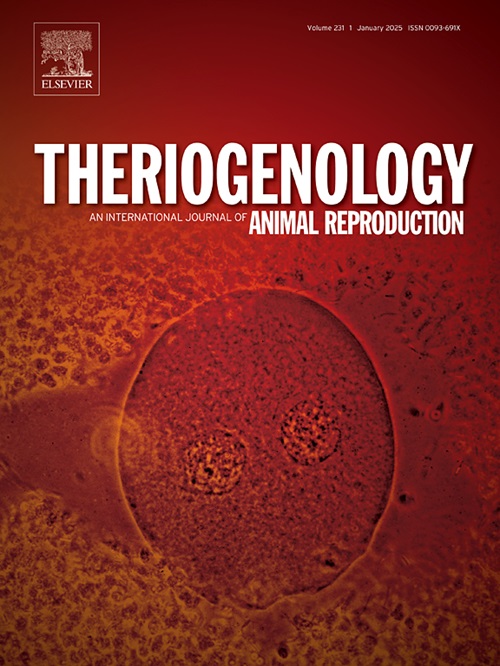oar-miR-29a promotes the establishment of endometrial receptivity by targeting CDC42 in sheep
IF 2.4
2区 农林科学
Q3 REPRODUCTIVE BIOLOGY
引用次数: 0
Abstract
Endometrial receptivity is vital for the successful implantation of embryos in sheep. Insufficient receptivity is a major cause of implantation failure, highlighting the need to understand the underlying mechanisms. MicroRNAs (miRNAs) play an essential role in the epigenetic regulation of endometrial receptivity and embryo implantation by influencing post-transcriptional processes. However, the specific mechanisms by which various miRNAs contribute to endometrial receptivity and embryo implantation in sheep remain to be fully elucidated. Our research highlights the significant role of oar-miR-29a, which promotes the migration and proliferation of sheep endometrial epithelial cells (sEECs). We found that oar-miR-29a enhances mRNA expression associated with proliferation, migration, and epithelial-mesenchymal transition (EMT) in sEECs. Additionally, this miRNA enhances the proliferation and migration capabilities of sheep trophoblast cells (sTCs). Moreover, our findings suggest that the target genes of oar-miR-29a are involved in key biological processes and pathways essential for embryo implantation. Notably, our analysis identifies cell division cycle 42 (CDC42) as a target gene of oar-miR-29a. In summary, oar-miR-29a plays a crucial role in promoting endometrial receptivity by targeting CDC42 in sheep. These findings provide insights into the miRNA-based regulatory mechanisms governing uterine physiology during the early stages of pregnancy, emphasizing the importance of this research for improving reproductive outcomes in sheep.

mir -29a通过靶向CDC42促进绵羊子宫内膜容受性的建立
子宫内膜容受性是绵羊胚胎成功着床的关键。接受性不足是植入失败的主要原因,强调需要了解潜在的机制。MicroRNAs (miRNAs)通过影响转录后过程在子宫内膜容受性和胚胎着床的表观遗传调控中发挥重要作用。然而,各种mirna参与绵羊子宫内膜容受性和胚胎着床的具体机制仍未完全阐明。我们的研究强调了ar- mir -29a在促进绵羊子宫内膜上皮细胞(sEECs)迁移和增殖中的重要作用。我们发现桨- mir -29a增强了seec中与增殖、迁移和上皮-间质转化(EMT)相关的mRNA表达。此外,该miRNA还能增强绵羊滋养层细胞(sTCs)的增殖和迁移能力。此外,我们的研究结果表明,卵巢- mir -29a的靶基因参与胚胎着床所必需的关键生物学过程和途径。值得注意的是,我们的分析确定细胞分裂周期42 (CDC42)是ar- mir -29a的靶基因。综上所述,mir -29a通过靶向CDC42在绵羊中促进子宫内膜容受性中起着至关重要的作用。这些发现揭示了基于mirna的妊娠早期子宫生理调控机制,强调了本研究对改善绵羊生殖结果的重要性。
本文章由计算机程序翻译,如有差异,请以英文原文为准。
求助全文
约1分钟内获得全文
求助全文
来源期刊

Theriogenology
农林科学-生殖生物学
CiteScore
5.50
自引率
14.30%
发文量
387
审稿时长
72 days
期刊介绍:
Theriogenology provides an international forum for researchers, clinicians, and industry professionals in animal reproductive biology. This acclaimed journal publishes articles on a wide range of topics in reproductive and developmental biology, of domestic mammal, avian, and aquatic species as well as wild species which are the object of veterinary care in research or conservation programs.
 求助内容:
求助内容: 应助结果提醒方式:
应助结果提醒方式:


